This is a Veteran Owned site

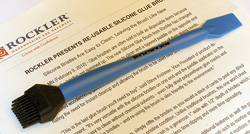 |
This really is a good idea that I nearly missed because it's press release came in the midst of a bunch of duds that I threw out! Click image to enlarge |
Rockler Silicone Glue Brush
Finally! Innovation that’s actually innovation!
Text, photos and video by Tom Hintz
Posted – 2-22-2012
I get press releases all the time that purporting to announce some heart-stopping innovation but well before the end of the release it becomes obvious that there is nothing new to be found. Then I get a release from Rockler and while my knee jerk reaction was to can it, I took the time to read it and found real live innovation! This is so rare I had to read it again but sure enough, real innovation!
The Basics
The Rockler Silicone Glue Brush actually looks a little odd for a woodworking tool. It has no wood in it and the ends are not familiar either. One end is paddle-shaped and they say that it can be used for putting glue in small areas, spreading glue and even putting glue in grooves and such. All of that makes sense and when I tried those things, it worked well. The other end features a molded silicone brush with odd-looking bristles. I had my doubts that this would spread glue very well but they say it will so we need to give it a try.
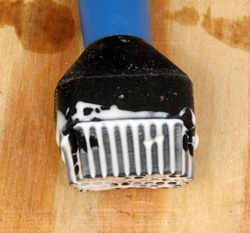 |
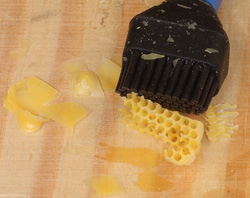 |
I loaded the Rockler Silicone Glue Brush with glue (left) and let it dry. Then I simply broke the glue (right) off of the brush. It really does work that easily! Click images to enlarge |
|
A Clean Break
An interesting part of the Rockler Silicone Glue Brush release refers to cleaning the silicone brush. You can wash water-based glue out under a faucet but you can also let it dry in place. The drying technique works with most glues including polyurethanes. Until you actually see what happens, letting the glue dry is kind of a leap of faith and I have to say I was a bit concerned when I did it the first time. It just didn’t feel right.
When the glue is fully dried and it’s looking like we just killed another glue brush you simply flex the silicone head a little and pull off the dried glue! You might have to pick a few bits of dried glue from between the bristles but it does come out easily and you essentially have a new brush! (Right here my mind was adding up all of the bags of acid brushes I have gone through before the Rockler Silicone Glue Brush came along…..could be thousands of acid brushes…)
In the Shop
There aren’t a bunch of options for testing a glue brush with the exception of purposely loading it up with glue and letting it dry. Aside from that I just glued up some boards using Gorilla Wood Glue which is handled and applied like any of the common woodworking glues.
I had my doubts about the shape of the Rockler Silicone Glue Brush but it actually handles very easily and puts glue right where I expected. I also thought that it might make furrows in the glue similar to a notched trowel for installing tile but while it does leave streaks in the glue, they are not large at all and seemed to have no impact on the glue joint. The bristles are in a tight enough pattern and are cut at an angle that allows the Rockler Silicone Glue Brush to leave a surprisingly consistent layer of glue as you brush it on.
Getting a thin coat of glue is always important and that is not hard to do with the Rockler Silicone Glue Brush. Even putting too much glue in one spot was not a big issue as the Rockler Silicone Glue Brush “pulled” the excess down the board and made it easy to even the coat out over the full surface being glued.
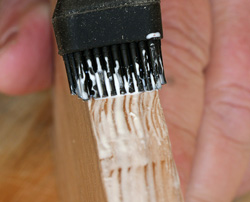 |
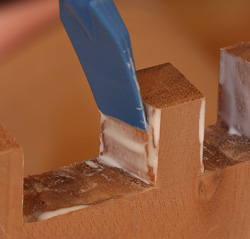 |
Applying glue along an edge (left) is very easy and the Rockler Silicone Glue Brush moves glue evenly. I found that the spade end (right) works great for applying glue to dovetails, especially if you use it vertically as there is virtually no glue on the outside of the joint! Click images to enlarge |
|
The paddle end also works well for putting glue in odd places like grooves and narrow dados. Another key use is spreading glue in dovetails, something at which the paddle end of the Rockler Silicone Glue Brush excels. I could put some glue on the paddle itself and spread it into the dovetail much easier than with my old acid brushes. There was also way less excess glue on the outside of the dovetail joint with the Rockler Silicone Glue Brush which makes sanding and finishing later just that much easier.
Finally, I looked at clean up. After gluing up my test pieces I washed the Rockler Silicone Glue Brush out with plain water and that works very well. I would find out later that a thin film of glue remained in a few places but that flakes off easily by just flexing the bristles.
I also loaded the Rockler Silicone Glue Brush up with the Gorilla Wood Glue and plopped it on the bench and waited for it to dry. Once again, the glue came out easily, this time nearly in one piece. I did have to flex the bristles a little to get some glue that remained between a few bristles after the main piece was pulled out.
Conclusions
If the Rockler Silicone Glue Brush does something wrong I doubt it has to do with gluing up wood in woodworking. I can’t see a thing wrong with this design but it is easy to find good things. It cleans up easily but when you forget the brush and the glue dries being able to just pull the glue off can save the day when you don’t have an extra bag of acid brushes on hand.
Video Tour |
Considering that Rockler sells the Rockler Silicone Glue Brush for $3.99 (2-22-2012) each you can start saving money quickly when your acid brushes run out. Not having to buy more bags of the acid brushes is nice but not having to find a usable glue brush in the shop when you’d rather not go out to buy some is even better.
I think the conclusion here is simple. The Rockler Silicone Glue Brush is a good idea that has utility in the shop. It’s not expensive, saves work and frustration plus it will save money in the near future. I can’t think of anything wrong with the Rockler Silicone Glue Brush or any good reasons not to use them.
Enter “silicone glue brush in the Rockler search box (top right on this page) and you can get yours ordered today.
Have a comment on this review? –Email Me!
All written, photographic and drawn materials are property of and copyright by NewWoodworker.com LLC 2000-2019. Materials may not be used in any way without the written permission of the owner.
